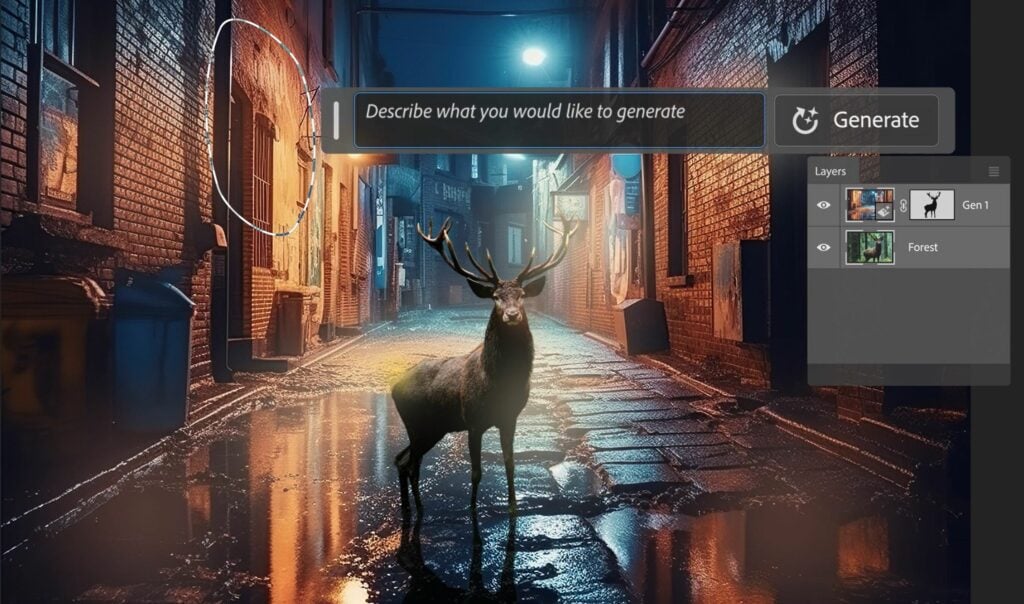TV Commercial Review
Memorable
Effective
Style
Heart or Humor
Execution
Clear
Good demo
In the realm of digital creativity, few brands carry as much weight as Adobe. Recently, the software giant unveiled a new advertisement featuring Firefly, their family of creative, generative AI models. With this bold step into the future, Adobe aims to redefine the creative landscape, but as with any groundbreaking innovation, the application and implications warrant scrutiny.
Adobe Firefly Demo Ad
According to the ad, Firefly has been integrated directly into Photoshop, pairing the speed and ease of generative AI with the power and precision of Photoshop. As the first in Adobe’s major initiative to incorporate generative AI into existing creative workflows, Firefly’s launch marks a pivotal moment in the evolution of design and creativity.
On the positive side, Firefly’s foremost advantage is its ability to streamline and speed up creative workflows. Leveraging AI, it can extend images, add and remove objects, thereby saving designers valuable time. Secondly, Adobe’s extensive history with AI innovation lends credibility and weight to this new venture. Users can reasonably expect the integration to be seamless, as it comes from a brand continuously delivering intelligent capabilities through Adobe Sensei into numerous applications. Lastly, the Generative Fill, powered by Firefly, which uses simple text prompts to add, extend or remove content from images, is set to revolutionize how designers work, presenting countless new possibilities.
However, as revolutionary as Firefly seems, there are areas of concern. The first among these is the potential misuse of AI-generated content. While Adobe has made efforts to ensure that Firefly won’t generate content based on other peoples’ or brands’ intellectual property (IP), the risk of misuse cannot be completely eliminated. Secondly, introducing such AI capabilities can potentially lead to job losses, as specific tasks traditionally performed by human designers may be rendered redundant. Lastly, while Adobe reassures that its AI capabilities are developed according to its AI Ethics principles, the extensive power and scope of AI always pose a risk to privacy and data security, and these concerns need to be addressed robustly.
Regardless of the pros and cons, Adobe’s Firefly offers a promising glimpse into the future of design and creativity. It is the dawn of a new era where technology serves as a ‘creative co-pilot’, fostering creativity and efficiency in equal measure.
About Adobe Firefly
In a world where artificial intelligence (AI) is becoming increasingly intertwined with our lives, Adobe has recently launched Firefly, its suite of generative AI models integrated with the ubiquitous Photoshop. This innovative move is the company’s first initiative to weave generative AI into creative workflows, making Firefly your creative co-pilot, but is it all smooth skies ahead?
Pros
- Revolutionizing Creativity: Firefly allows users to add, remove, or extend the content in images in a matter of seconds using simple text prompts. This feature is designed to speed up creativity, exploration, and production processes, transforming the traditionally tedious and time-consuming photo editing task.
- Enforcing Intellectual Property Rights: Firefly has been trained on Adobe Stock’s licensed images, ensuring that generated content does not infringe on the IP rights of others. It provides a safe platform for commercial use, which will be a relief in a world where content is constantly being copied and shared without attribution.
- Content Authenticity: To address growing concerns about AI-generated content, Adobe has developed Content Credentials. This digital “nutrition label” indicates whether a piece of content is AI-generated or AI-edited, enabling consumers to make informed decisions about the digital content they encounter.
Cons
- Potential for Misuse: As with any AI tool, there is a risk of misuse. Despite Adobe’s efforts with Content Credentials, it’s still possible for manipulated images to be shared without this context, leading to misinformation or manipulation.
- Job Threat: With Firefly doing much of the heavy lifting in creative processes, it could potentially reduce the need for graphic designers. While Adobe presents Firefly as a creative “co-pilot”, there are justified fears that automation could lead to job losses in the industry.
- Lack of Originality: Despite the efficiency gains, AI-generated content may lack the personal touch and creativity that comes from human designers. As AI does not understand emotion, culture, or nuanced human experience, there is a risk that the generated content might become generic and uninspiring.
While Adobe’s Firefly promises to be a game-changer for creative workflows, only time will tell how it will be received by the industry. As we stand on the brink of this AI-infused era, Adobe’s Firefly could either herald an era of unprecedented creativity or cast a long shadow over the design industry.

Adobe Firefly Press Release Statements
“By integrating Firefly directly into workflows as a creative co-pilot, Adobe is accelerating ideation, exploration, and production for all of our customers,” said Ashley Still, senior vice president, Digital Media at Adobe. “Generative Fill combines the speed and ease of generative AI with the power and precision of Photoshop, empowering customers to bring their visions to life at the speed of their imaginations.”
Supercharging Creativity and Design
The deep integration of next-generation AI across Photoshop’s core tools uniquely enables new creative workflows that supercharge ideation with precise creative control for production-quality content creation.
Generative Fill automatically matches the perspective, lighting, and style of images to enable users to achieve astounding results while reducing tedious tasks. Generative Fill expands creative expression and productivity and enhances the creative confidence of creators with the use of natural language and concepts to generate digital content in seconds:
- Powered by Firefly: Firefly is designed to generate images that are safe for commercial use and is trained on Adobe Stock’s hundreds of millions of professional-grade, licensed, high-resolution photos, helping ensure Firefly won’t generate content based on other peoples’ or brands’ intellectual property (IP).
- Magically leap from idea to image with simple text prompts: Add, extend, or remove content from images to achieve astounding results.
- Edit non-destructively: Create newly generated content in generative layers, enabling you to rapidly iterate through myriad creative possibilities and reverse the effects when you want without impacting your original image.
- Create at a transformative rate: Experiment with off-the-wall ideas, ideate different concepts, and produce endless variations of high-quality content as fast as you can type.
- Available as a web tool: Generative Fill is also available as a new module in the Firefly beta for users interested in testing the new capabilities on the web.
About Adobe and Artificial Intelligence
Adobe is making the world more creative, productive, and personalized with AI as a co-pilot that amplifies human ingenuity. For decades, Adobe has delivered hundreds of intelligent capabilities across Creative Cloud, Document Cloud, and Experience Cloud through Adobe Sensei, enabling customers to create, work and collaborate more efficiently.
Firefly, Adobe’s family of creative, generative AI models, brings even more precision, power, speed and ease directly into Adobe workflows. It is the market’s most differentiated generative AI offering, trained on a unique dataset that generates commercially viable, professional-quality content.
Adobe Sensei GenAI services are redefining how businesses deliver customer experiences by delivering more speed and productivity across Adobe Experience Cloud workflows. Sensei GenAI will enable brands to instantly generate and modify text-based experiences across any customer touchpoint and leverage different large language models (LLMs). These innovations are anchored in Adobe Experience Platform (AEP), which brings customer data and content together across an organization under one common language model.
As a trusted partner to individuals and businesses of all sizes, Adobe develops and deploys all AI capabilities with a customer-centric approach and according to its AI Ethics principles to ensure content and data transparency. Content Credentials provide “nutrition labels” for digital content and are a key pillar of Adobe’s AI principles.














